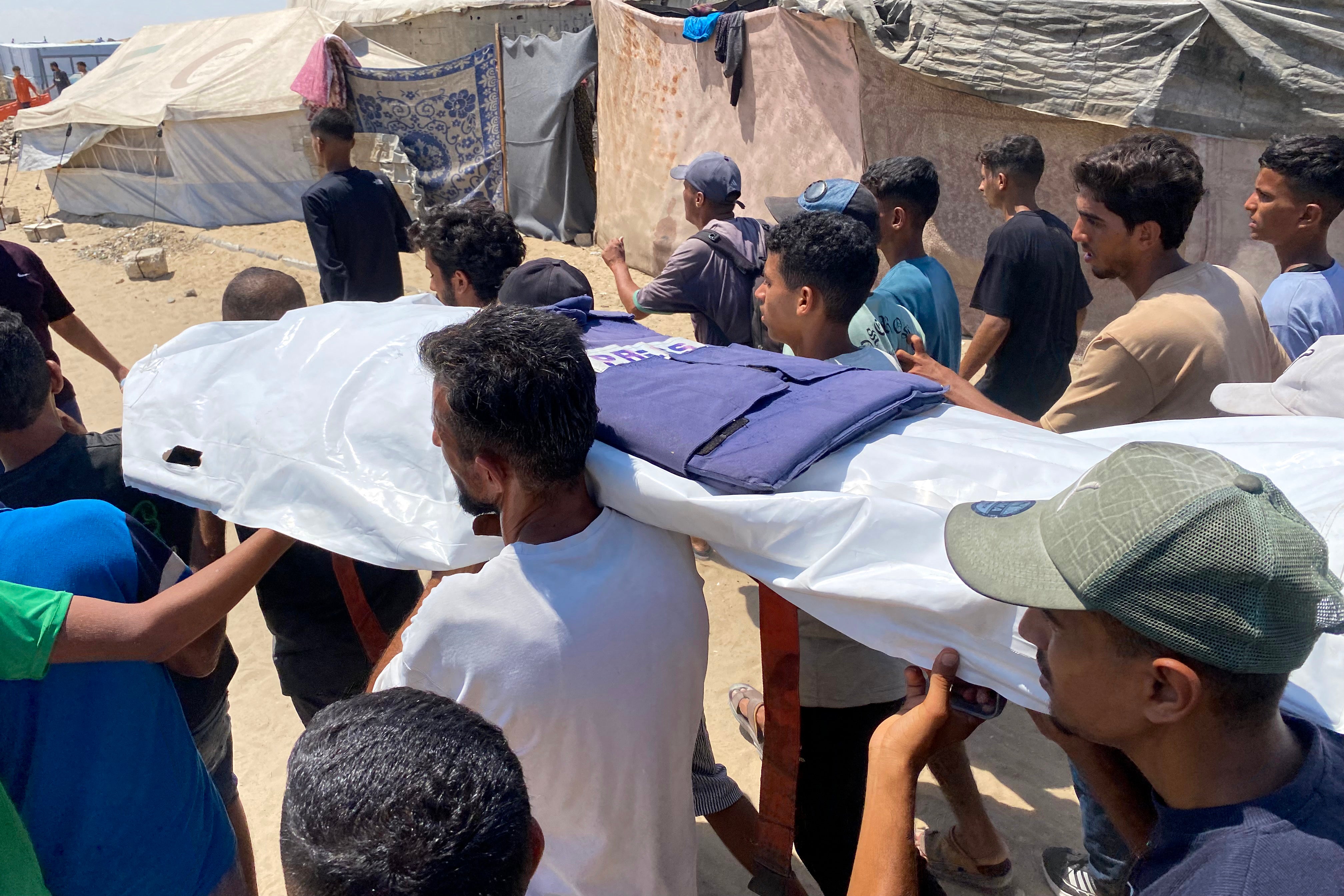A video broadcast earlier this week captured the horrifying moment rescuers and journalists were killed in a “double-tap” strike on the Nasser hospital in southern Gaza.
They had rushed to the scene of an initial Israeli attack, only for the same location to be bombed minutes later. Five journalists and several medical staff were killed by the second strike.
The attack prompted a wave of international condemnation. UK foreign secretary David Lammy wrote on social media: “Horrified by Israel’s attack on Nasser hospital. Civilians, healthcare workers and journalists must be protected. We need an immediate ceasefire”.
Israel’s prime minister, Benjamin Netanyahu, initially called the strikes a “tragic mishap”. He added: “Israel values the work of journalists, medical staff and all civilians”. But the strikes have now been characterised by Israel as a targeted attack on Hamas fighters.
An initial inquiry by Israel’s military says “it appears” its troops “identified a camera that was positioned by Hamas in the area of the Nasser hospital that was being used to observe the activity of IDF troops” in order to direct attacks against them.
Whether or not charges relating to the attacks are ever brought remains to be seen. But James Sweeney of Lancaster University’s School of Law believes there should be no doubt that the double tap tactic falls into the category of acts of war that are prohibited by the law of armed conflict.

Professor Sweeney examines how international law operates in situations like this, identifying four fundamental rules on methods that govern the conduct of hostilities: humanity, necessity, distinction and proportionality.
He says the Israeli strikes almost certainly breached the rule on distinction, which requires that only lawful objectives should be targeted for attack. He explains that there are very limited circumstances in which a hospital or its medical staff could ever be a lawful target. The same goes for journalists. Both are protected under the Geneva Conventions.
Professor Sweeney also sees Israel’s attack as violating the rule on proportionality, which says expected “collateral damage” should not be excessive to the expected military advantage of the attack. Even if the claim that the hospital was being used by Hamas to stage attacks on Israeli forces stands up, thus possibly making it a lawful target, the collateral damage was likely going to be vast.
Excessive collateral damage has been a grim theme of the war. Israeli government officials consistently say their military works hard to keep civilian harm to a minimum, for example by making phone calls and sending text messages to those residing in buildings designated for attack.
However, Israel’s own numbers cast doubt on this claim. Figures from a classified Israeli military intelligence database, reported by the Guardian last week, indicate that 83 per cent of the Palestinians killed by Israeli forces in Gaza have been civilians. This is a rate of civilian killing far higher than other modern wars, says Neta Crawford of the University of Oxford.
Professor Crawford, an expert on international relations, reports that western militaries began to take steps to minimise inadvertent harm to civilians after the Vietnam war in 1975. These practices, which include making collateral damage estimates prior to carrying out a strike, have not always been adhered to.
.jpeg)
But when they have been followed, the rate of civilian killing has been reduced. In American wars in Iraq and Afghanistan, Professor Crawford reports, civilian casualty rates were 68 per cent and 26 per cent respectively – far lower than in Gaza.
“Given the kind of war Israel is fighting – using large, indiscriminate weapons to destroy buildings and failing to distinguish between combatant and noncombatant – it has unsurprisingly produced high civilian casualty rates,” she says.
Peacekeeping in Lebanon
The UN security council, meanwhile, is voting on whether to extend a long-running peacekeeping mission in Lebanon for one final time. Vanessa Newby and Chiara Ruffa of Monash University and Sciences Po respectively reported earlier this week that the mission, which has patrolled Lebanon’s southern border with Israel since 1978, is at risk of being discontinued.
The Trump administration wants to reduce US financial commitments to UN peacekeeping. It argues that expensive and longstanding missions should be downsized to cut costs. Israel has, at the same time, insisted that the mission has been ineffective in addressing the existential threat posed by Hezbollah.
Dr Newby and Professor Ruffa are critical of this latter assessment. They write that the mission’s mandate has never been to disarm Hezbollah directly. Instead, it is tasked with creating and maintaining a space free of armed groups in southern Lebanon by supporting the Lebanese armed forces.
The council is reportedly expected to adopt a French draft resolution that sees the operation continue until the end of 2026. It will then begin a year-long “orderly and safe drawdown and withdrawal” – a compromise with the US.
This is a welcome outcome. Dismantling the peacekeeping mission would, in Dr Newby and Professor Ruffa’s view, create a dangerous security vacuum along the Israeli-Lebanese border.
Lebanon’s army remains weak, so a sudden withdrawal risks a surge in Hezbollah activity in the south. This would increase the prospect of another direct conflict between Hezbollah and Israel, they say, and another Israeli invasion of Lebanon.

‘Fortress belt’
Russia is continuing to pound Ukrainian towns and cities, most recently launching strikes on Kyiv that killed at least 17 people. Ukraine’s president, Volodymyr Zelensky, has accused Moscow of choosing “ballistics instead of the negotiating table”, while UK prime minister Keir Starmer says Russia’s continuing attacks are “sabotaging hopes of peace”.
Talks on ending the war have been taking place for several weeks, though there has been no breakthrough. Russian leader Vladimir Putin is demanding that Kyiv cede control of the entirety of its Donetsk oblast, a region in eastern Ukraine, to Russia.
The Trump administration, keen for the war to end, seems to back this idea. When asked a question recently about Russia keeping territory it has seized, vice-president J.D. Vance remarked that “every major conflict in human history” has ended “with some kind of negotiation”. Chris Smith, a historian at Coventry University, interrogates the truth of this claim here.
Kyiv is unsurprisingly resistant to Putin’s demands. Rod Thornton and Marina Miron, security experts at King’s College London, say this would effectively be tantamount to an acceptance of overall defeat for Ukraine. Kyiv would be giving up its principal defensive barrier against further Russian encroachment into the rest of the country.
Dr Thornton and Dr Miron stress the strategic importance of Ukraine’s so-called “fortress belt” – the name given to the complex series of defensive lines established between towns and cities in the west of the Donetsk region. Russia has largely been unable to break through these lines, so has been prevented from surrounding any major urban area there.
Gaining control of western Donetsk is the key to winning the war, write Dr Thornton and Dr Miron. So Putin, unable to break through the fortress belt, is now trying to acquire it through a peace deal brokered with US assistance. This would settle the war, but in Russia’s favour.
Meanwhile a far larger belt of fortifications is taking shape across eastern Europe, as Russia’s neighbours race to protect themselves in light of the war in Ukraine. Natasha Lindstaedt, a specialist in authoritarian regimes at the University of Essex, believes the recent shift in US foreign policy and its telegraphed move away from being Europe’s security guarantor, has prompted countries including Finland, the Baltic states and Poland to take extra precautions.
As Dr Lindstaedt explains, these border defences will be using the latest technology and early warning systems and artillery units. The project is going to require a high level of cooperation between these countries to ensure that there are no loopholes which could be exploited by a Russian offensive.
The hope is that all concerned have learned the lesson of the much-vaunted French Maginot Line, which Germany simply bypassed during the Second World War.
Sam Phelps is Commissioning Editor, International Affairs, at The Conversation UK
This article was originally published by The Conversation and is republished under a Creative Commons licence. Read the original article



